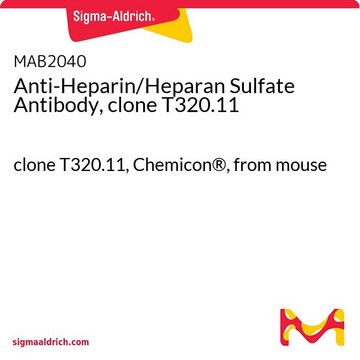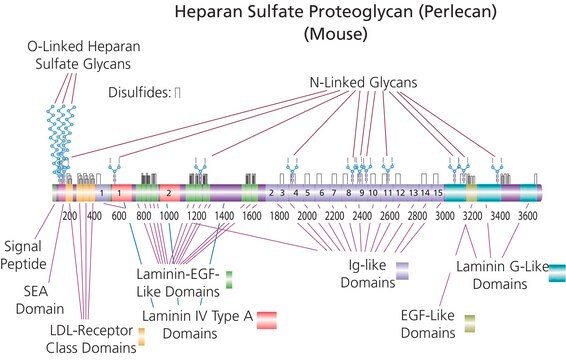MAB1948P
Anti-Heparan Sulfate Proteoglycan (Perlecan) Antibody, clone A7L6
clone A7L6, from rat
Synonym(s):
heparan sulfate proteoglycan 2, Schwartz-Jampel syndrome 1 (chondrodystrophic myotonia), endorepellin (domain V region), perlecan proteoglycan, heparan sulfate proteoglycan of basement membrane
About This Item
Recommended Products
biological source
rat
Quality Level
antibody form
purified antibody
antibody product type
primary antibodies
clone
A7L6, monoclonal
species reactivity
human
technique(s)
immunocytochemistry: suitable
immunohistochemistry: suitable
immunoprecipitation (IP): suitable
western blot: suitable
isotype
IgG2aκ
NCBI accession no.
UniProt accession no.
shipped in
wet ice
target post-translational modification
unmodified
Gene Information
human ... HSPG2(3339)
General description
Heparan Sulfate Proteoglycan antibodies, in tissues, react strongly and uniformly with basement membranes. Clone A7L6 recognizes domain IV of the core protein of the large heparan sulphate proteoglycan or perlecan. The reactivity is independent of the galactosaminoglycan moieties; therefore, the epitope is not sensitive to heparinase treatment.
Specificity
Immunogen
Application
Western Blot Analysis: A previous lot was used in independent laboratories in WB. (Hagen, 1993; Brown, 1999).
Immunoprecipitation Analysis: A previous lot was used by an independent laboratory in IP. (Couchman, 1989).
Cell Structure
ECM Proteins
Quality
Immunocytochemistry Analysis: 1:500 dilution of this antibody detected Heparan Sulfate Proteoglycan in HeLa and A431 cells.
Linkage
Physical form
Storage and Stability
Analysis Note
HeLa and A431 cells
Other Notes
Disclaimer
Not finding the right product?
Try our Product Selector Tool.
Storage Class
12 - Non Combustible Liquids
wgk_germany
WGK 1
flash_point_f
Not applicable
flash_point_c
Not applicable
Certificates of Analysis (COA)
Search for Certificates of Analysis (COA) by entering the products Lot/Batch Number. Lot and Batch Numbers can be found on a product’s label following the words ‘Lot’ or ‘Batch’.
Already Own This Product?
Find documentation for the products that you have recently purchased in the Document Library.
Our team of scientists has experience in all areas of research including Life Science, Material Science, Chemical Synthesis, Chromatography, Analytical and many others.
Contact Technical Service







